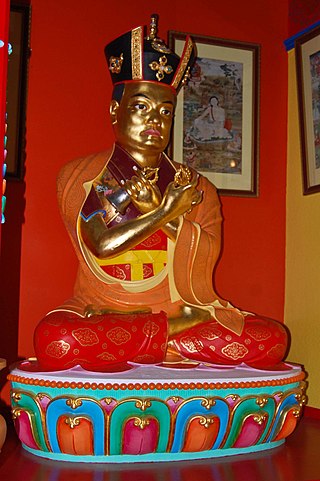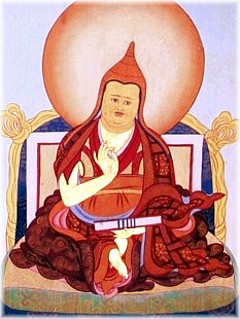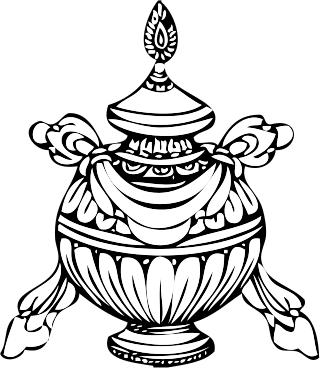
The Kadam school of Tibetan Buddhism was an 11th century Buddhist tradition founded by the great Bengali master Atiśa (982–1054) and his students like Dromtön (1005–1064), a Tibetan Buddhist lay master. The Kadampa stressed compassion, pure discipline and study.

The Tibetan Buddhist canon is a defined list of sacred texts recognized by various schools of Tibetan Buddhism. The Canon includes the Kangyur, which is the Buddha's recorded teachings, and the Tengyur, which is commentaries by great masters on the Buddha's recorded teachings. The first translation into Tibetan of these manuscripts occurred in the 8th century and is referred to as the Ancient Translation School of the Nyingmas.

The Jonang is a school of Indo-Tibetan Buddhism. Its origins in Tibet can be traced to the early 12th century master Yumo Mikyo Dorje. It became widely known through the work of the popular 14th century figure Dolpopa Sherab Gyaltsen. The Jonang school's main practice is the Kālacakra tantra, and they are widely known for their defense of the philosophy known as shentong.

Nyingma, often referred to as Ngangyur, is the oldest of the four major schools of Tibetan Buddhism. The Nyingma school is founded on the first lineages and translations of Buddhist scriptures from Sanskrit into Tibetan in the eighth century, during the reign of King Trisong Detsen.

Gampo Abbey is a Western Buddhist monastery in the Shambhala tradition in Nova Scotia, Canada on the edge of the Pleasant Bay community. Founded by Chögyam Trungpa Rinpoche in 1983, it is a lineage institution of Shambhala and a corporate division of the Vajradhatu Buddhist Church of Canada.

Trinley Thaye Dorje is a claimant to the title of 17th Karmapa.

Jamgön Kongtrül Lodrö Thayé, also known as Jamgön Kongtrül the Great, was a Tibetan Buddhist scholar, poet, artist, physician, tertön and polymath. He is credited as one of the founders of the Rimé movement (non-sectarian), compiling what is known as the "Five Great Treasuries". He achieved great renown as a scholar and writer, especially among the Nyingma and Kagyu lineages and composed over 90 volumes of Buddhist writing, including his magnum opus, The Treasury of Knowledge.

Karma Kagyu, or Kamtsang Kagyu, is a widely practiced and probably the second-largest lineage within the Kagyu school, one of the four major schools of Tibetan Buddhism. The lineage has long-standing monasteries in Tibet, China, Russia, Mongolia, India, Nepal and Bhutan, with current centres in over 60 countries. The spiritual head of the Karma Kagyu is the Gyalwa Karmapa; the 2nd among the 10 Karmapas had been the principal spiritual advisors to successive emperors of China. The Karma Kagyu are sometimes called the "Black Hat" lamas, in reference to the Black Crown worn by the Karmapa.

Jamyang Khyentse Wangpo, also known by his tertön title, Pema Ösel Dongak Lingpa, was a teacher, scholar and tertön of 19th-century Tibet. He was a leading figure in the Rimé movement.

Jamgön Ju Mipham Gyatso, or Mipham Jamyang Namgyal Gyamtso (1846–1912) was a very influential philosopher and polymath of the Nyingma school of Tibetan Buddhism. He wrote over 32 volumes on topics such as painting, poetics, sculpture, alchemy, medicine, logic, philosophy and tantra. Mipham's works are still central to the scholastic curriculum in Nyingma monasteries today. Mipham is also considered to be one of the leading figures in the Rimé (non-sectarian) movement in Tibet.
Ven. Paltul Rinpoche is a Baram Kagyü lineage holder, one of the four major sub-schools of the Kagyü Order in Tibetan Buddhism. There are four major orders in Tibetan Buddhism in Tibet. The present Paltul Rinpoche is the fifth lineage holder of the previous four masters of Tibetan Healing Arts and Meditation. He also is the teacher and head of Demo Monastery, located in the Nangchen region of Kham, Eastern Tibet. His Demo Monastery also incorporates a Traditional Institute of Medicine and Tibetan Astrology, as well as a hospital for the local nomadic population.

Khenpo Tsültrim Gyamtso Rinpoche was a Tibetan scholar yogi in the Kagyu tradition of Tibetan Buddhism. He taught widely in the West, often through songs of realization, his own as well as those composed by Milarepa and other masters of the past. "Tsültrim Gyamtso" translates to English as "Ocean of Ethical Conduct". He died on 22 June 2024, at the age of 90.

Dzongsar Khyentse Chökyi Lodrö was a Tibetan lama, a master of many lineages, and a teacher of many of the major figures in 20th-century Tibetan Buddhism. Though he died in 1959 in Sikkim, and is not so well known in the West; he was a major proponent of the Rimé movement within Tibetan Buddhism, and had a profound influence on many of the Tibetan lamas teaching today.
Geshe or geshema is a Tibetan Buddhist academic degree for monks and nuns. The degree is emphasized primarily by the Gelug lineage, but is also awarded in the Sakya and Bön traditions. The equivalent geshema degree is awarded to women.

Tertön Sogyal Lerab Lingpa was a Tibetan Buddhist tertön and a teacher of the Thirteenth Dalai Lama.

Khenchen Palden Sherab Rinpoche, also known as "Khen Rinpoche," was a teacher, a scholar, a lama, and a Dzogchen master in the Nyingma school of Tibetan Buddhism. He was considered by Penor Rinpoche to be one of the most learned living Nyingma scholars. Palden Sherab founded the Orgyen Samye Chokhor Ling Nunnery, the first nunnery in Deer Park (Sarnath).

Nalanda Buddhist Institute (NBI), also known locally as Daley Goenpa or Dalida, is a Buddhist monastic school (shedra) in the western part of the Punakha District (Dzongkhag) in Bhutan. It is below Talo Monastery and above Walakha, about a 25-minute drive from the main highway to Punakha. The name Nalanda means "insatiable giving".
The Madhyamakāvatāra is a text by Candrakīrti on the Mādhyamaka school of Buddhist philosophy. Candrakīrti also wrote an auto-commentary to the work, called the Madhyamakāvatārabhasya.

The Sheja Dzö or "Treasury of Knowledge" is a voluminous work by Jamgon Kongtrul (1813–1899). It is constituted by a root text in verse "The Encompassment of All Knowledge" and an autocommentary in prose, 'The Infinite Ocean of Knowledge'. The Treasury of Knowledge is widely considered Jamgon Kongtrul's masterpiece, covering the full spectrum of Buddhist history according to the knowledge then current in the Himalayas; the Abhidharma through the lens of Vasubandhu ; the Buddhist philosophy preserved, categorized and developed in the Himalayas; and the many streams of Buddhist sādhanā both exoteric (sutrayana) and esoteric (vajrayana), transmitted to, maintained and developed by the many trans-Himalayan lineages, such as Mahamudra and Dzogchen. The breadth of the Sheja Dzö is encyclopedic and its approach ecumenical. The root text in verse is terse and ostensibly glib approaching telegraphic. Whereas, the tone and register of the commentary is non-sectarian in regards to the many systems of Buddhadharma it enshrines. The Sheja Dzö is the central reference and general auspice work in Rimé movement literature.
Shentong is term for a type of Buddhist view on emptiness (śūnyatā), Madhyamaka, and the two truths in Indo-Tibetan Buddhism. It is often contrasted with the term rangtong ("self-emptiness"). The term refers to a range of views held by different Tibetan Buddhist figures.


















